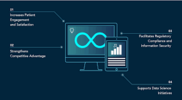Three Tools That Will Enable Your Team To Leverage DevOps Methods

Source:-forbes.com
Almost 20 years ago, I worked at a company that did source code management with zipped files passed around via email at the end of every day. We crossed our fingers that there weren’t going to be any dependency issues. This might (read as: should) sound laughable today, but my personal experience tells me there are still an awful lot of companies out there for whom this is true, and DevOps methodologies are still way out of reach.
Great tooling, like git and other modern source code repositories, have made my story feel like a joke of a distant past. But without such tooling, improving that situation is very difficult. Most methodologies in tech require a new kind of tooling to enable adoption. When your company decides to iterate on how it does something, sticky notes and zip files are going to be a great solution for only a few problems. Technological solutions are often a requirement for tech teams.
The term “DevOps” is already becoming somewhat worn-out (certainly, it no longer carries the excitement it did a few years ago), and this change is happening long before every company has adopted these practices. Tearing down walls between development and operations requires cultural change as much as anything, but tooling can help the process along. While tools aren’t an end in and of themselves, great tooling will help your organization innovate, and we all want to innovate faster.
Here are three open-source tools that push your organization toward continual improvement:
1. Jenkins
DevOps as a culture hinges on the ability to enable your development teams to iterate quickly without an additional step of “getting everything working” with a separate operations team. When you’ve implemented a tool like Jenkins, suddenly your developers have an interface they can work with and understand. Rather than handing their code to an operations team and crossing their fingers that they’ll be able to figure it out, they can deploy and test themselves.
PROMOTED
Google Cloud BRANDVOICE
| Paid Program
What Does Fairness in AI Mean?
Tableau APAC BRANDVOICE
| Paid Program
Building Communities To Drive Organisational Success In Asia Pacific
Civic Nation BRANDVOICE
| Paid Program
The Indelible Impact Of My HBCU Experience
Giving the people building your application the tools that enable them to deploy things to staging and testing environments — and then to push to production — helps evolve your team towards DevOps culture. Whether your development team will then own the ramifications of the things they’re running in production is a cultural question specific to every organization. But because you implemented a repeatable and understandable tool, it is now a possibility.
If you do venture outside open-source tooling, one tool I’ve found success with is CircleCI, a partner of ours.
2. Kubernetes
Deploying a service is less than half the battle if it isn’t running in a way that can scale up and down and interact well with the rest of your application stack. Kubernetes is a buzzword today in the way DevOps was a few years ago because of what it has enabled. If DevOps is a methodology, Kubernetes is a means to get there.
Kubernetes abstracts away everything about managing a server, or a whole host of servers (be they in your data-center or in the cloud), so again, your team has a simple and well-documented API it can understand rather than a mass of accreted complexity that only the most grizzled of your engineers can comprehend.
Kubernetes won’t solve all of your problems, but it has the documentation and the community backing to be a trustworthy direction in which to take your company. It’s not going away anytime soon.
On top of this, setting up a cluster shouldn’t be difficult anymore. Take a look at various cloud platforms for their tooling options.
3. Prometheus
Now your teams have a way for engineers to deploy their work directly to production and an API they can work with to manage the scaling and internal networking for further innovation. But none of this matters if you haven’t built robust monitors to know when things (inevitably) go wrong so you can respond. There are many tools out there you can leverage to build great monitoring, including (a partner of ours) as a paid option. On the open-source side of things, Prometheus has done an excellent job of staying on top of the market need for innovation. The tool is mature anDatadog d offers a good mixture of configurability and ease.
With great monitoring in place, your teams will know what is working and what isn’t — and know when they need to respond to keep your company from losing money to downtime.
A Leap Of Methodology
As mentioned earlier, tools don’t solve all of your problems, but a great leap in methodology will often require a tool to enable the solution.
The velocity of organizational improvements is increasing because of great tooling. Without the right implementation, throwing resources at tools can exacerbate existing problems. But change doesn’t have to be scary, and product development doesn’t have to slow to a trickle to adopt new things. When you, as a leader, hope for great improvements in your organizational methodology, you can expect that great tooling will be required.